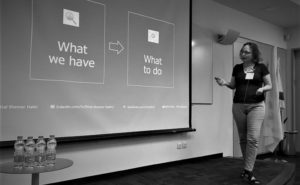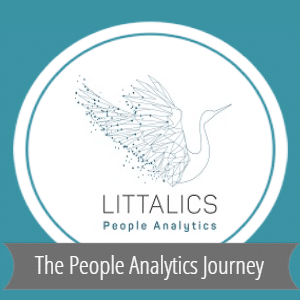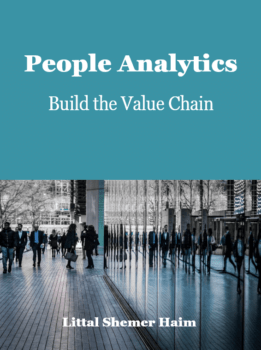People Analytics practices have many facets: engaging business leaders, establishing processes and deliverables and setting the ground for intervention in organizational culture and change management. However, none of these will be possible without a proper understanding of the foundations of data analytics. So, how to lead with data?
I was honored to participate in the experts’ panel that opened the Hacking HR online event “leading with data” and discuss the foundational elements of data analytics. It was a fantastic opportunity to meet my colleagues again, Sheri Feinzig, Max Blumberg, Soumyasanto Sen, and Jordan Morrow. We highlighted moving forward from concepts to design and implementation of People Analytics. This insightful and delightful panel could not happen without the excellent leading of Enrique Rubio, with whom I had the honor to collaborate many times in local and global events.
Naturally, experts’ panel discussions are fast and dynamic. The panelists raise their insights briefly and then quickly move to the next question. But there’s wisdom behind every short idea they contribute, so it is worthwhile to explore them in detail. Therefore, after watching the entertaining video of this panel, you can expand your knowledge by reading this article and its references.
Although the panel conversation developed in different directions, and you may find many inspiring ideas in it, I’m focusing here on four topics, which I believe are most crucial: common mistakes when approaching workforce data analysis; things to do about the messy workforce data; complementing dashboards with advanced analytics; reproducibility is a necessity.
Common mistakes when approaching workforce data analysis
People Analytics is all about exploring, inferring, and communicating data patterns to support decisions related to people. But to do so, you need a data strategy. I suggest thinking about the workforce data strategy as a funnel, in which you pour business questions and extract actionable insights. The funnel consists of platforms to store, analyze and visualize data.
Whatever platforms or tools you use, always start with business questions and reach actionable insights. A common mistake is to begin your analytics initiative with data analysis and not a question in mind. There is always a high chance of finding exciting results, but they will not affect the business, aside from losing valuable managerial attention.
Another common mistake is to postpone any analysis until the entire workforce data is perfect. Unfortunately, it will not happen any time soon. The secret sauce of success is to identify relevant data sources for your business question, focus on optimizing these data, and strive to optimize accordingly the procedures or work routines in which you collect the data.
Workforce data is a mess, but we can do something about it
It is crucial to understand the complexity of workforce data. It may be scattered on many platforms, both in the HR department and in different lines of business. It comes in many formats, structured and unstructured. Sometimes, it might not be recorded digitally, or might be replaced, or be kept in supplement records elsewhere. Sometimes we don’t have a unique identifier for all data sources, making it impossible to match records.
Data preparation is a part of every analytics project. But, unfortunately, you don’t get ready-made tidy data. It is a milestone in your analytics project, but you need to get there yourself. From my experience in many quantitative types of research in organizations, this is an effective way to be engaged with your data, understand it, and reach the most in-depth acquaintance with it.
So right after the crucial stage of transforming a business question into the hypothesis that comprises your analytics project and spotting relevant data sources, you pull and merge datasets and start exploring them. The exploration phase starts with finding gaps in data quality and fixing them. You will indeed find systematic errors. However, it will lead you eventually to propose or come up with new procedures to maintain data integrity.
Dashboards are not sufficient for analytics; other solutions are needed
Practically, both dashboards and other People Analytics projects deal with some kind of Performance. However, each practice has a different approach: Dashboards enable us to present different KPIs and answer questions, e.g., did we reach our goals? However, by using dashboards, we actually can’t answer the question: “Why?” For that purpose, we need a People Analytics project or solution, which enables us to understand the factors that drive those KPIs that we presented on our dashboards.
Thus, the company needs both dashboards and People Analytics practices because it must be aware of its KPIs, and it also needs to understand how to improve those exact KPIs.
Reproducibility is a necessity
No matter how you analyze HR data, your methods will fall into one or more of four categories: Research software, BI tools, Data science programming, and People Analytics products. However, the ability to reproduce your results is not the same in all of them.
Reproducibility is essential because it ensures transparency and gives us confidence in understanding what was done with the data. Many HR departments still rely on Excel in their analytics endeavors. However, a high level of expertise is needed to document your work on this software so others can track or reproduce it.
Data scientists use software applications that provide the facilities for code-writing in programming languages such as Python or R. They can leverage the access to libraries that contain ready-made code for plenty of objectives and can contribute their own code while writing everything from scripts to projects to enterprise applications to deal with any business question related to the workforce. A significant advantage in using R or other programming languages is the inherited reproducibility.







